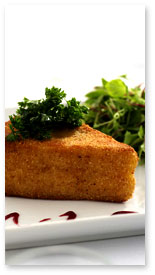 German style Baked Camembert with Red Currant Sauce
German style Baked Camembert with Red Currant Sauce
From: Saveur
SERVES 4
Four 4.5-ounce rounds Camembert cheese
2 cups flour
2 large eggs
1/2 cup whole milk
2 cups plain breadcrumbs
2 tablespoons extra virgin olive oil
2 tablespoons unsalted butter
8 ounces German red currant preserves
Parsley for garnish
 Preheat oven to 450 degrees F.
Preheat oven to 450 degrees F.
Place the flour in a shallow dish. In a second shallow dish, whip the eggs and milk to create an eggwash. Place the bread crumbs in a third shallow dish.
Dredge the first round of Camembert in the flour and make certain it’s completely coated. Remove the Camembert and tap off all excess flour. Place the floured round into the eggwash. Completely cover it with egg. Remove the Camembert from the eggwash, gently shaking it to remove any excess, and place it in the bowl containing the breadcrumbs. Completely cover the round in breadcrumbs and then remove it from the dish, tapping the cheese to remove all excess breadcrumbs. Repeat the process with the round so that it is double-breaded, and then repeat the entire process with the remaining rounds of Camembert. Place the breaded rounds in the refrigerator while you prepare the pan for sautéing. It is important that you move quickly, as you do not want the breadcrumbs to get soggy.
Melt the olive oil and butter in a medium sauté pan over high heat. Remove the first Camembert round from the refrigerator and place it in the hot sauté pan. Sauté it on each side until light golden brown, about 1 minute each side. Repeat the process with the remaining rounds.
Place the rounds into your preheated oven and cook until the Camembert softens, 5 to 7 minutes.
Meanwhile, place the preserves in a medium sauté pan and warm over high heat.
Place a round on each serving plate. Spoon the warmed preserves onto the plate next to the baked Camembert. Garnish the top of each with parsley and serve immediately.
Why double-bread?
Delicate items are coated with breadcrumbs prior to sautéing or baking so that they maintain their shape and appearance during the cooking process. With items that melt during cooking, such as Camembert, double-breading is crucial. Why? Any uncoated surface area provides a “door” through which the item could escape into the pan or baking dish. Many people are therefore tempted to load on the flour, eggwash, and breadcrumbs in one step, which results in uneven breading, an unpleasant appearance, and a floury, scrambled eggs flavor that detracts from the flavor of the breaded item.
Double-breading is a much better alternative, as you build up two layers of light breading that will properly seal the item without masking its flavor. While double-breading, it’s important to keep your fingers as clean as possible, as eggwash left on your fingers pulls off the breadcrumbs during handling. It may take a bit of practice to master double-breading, but trust me, it’s worth it. You don’t want to lose even one drop of Camembert in this recipe.

